In the drive toward the clean energy transition, energy efficiency is perhaps a bigger potential contributor than all other elements combined. Most of the energy used in the electricity system is wasted before it gets to the consumer. As little as 5% of the primary energy source ends up becoming useful electrically powered work. To date, much of the energy efficiency focus has centered on the generation and consumption of power – for instance, the use of combined cycle gas turbines or LED lighting. But now there’s more attention being paid to the transition and distribution system, where so much energy loss is occurring.
Technical Approaches to Improving T&D Efficiency
Given the transmission and distribution network is made up of conventional metal cables that possess electrical resistance, losses are inevitable. These losses come from the generation of heat in cables, but also across every stage of the transmission process including conversion losses in transformers and condensers. An advanced economy will typically see T&D losses of around five to seven percent, although these losses vary wildly between nations. According to the World Bank, Singapore records T&D losses of around 2% while the United States hits 6%. There are multiple factors at play, but the advent of HVDC technologies has improved grid efficiency.
Additionally, the more widespread deployment of HVDC has coincided with the increased use of renewables. This is primarily because the best renewable energy resources are not usually found near demand centers and must therefore be transmitted long distances from the site of production to the demand location. Given transmission losses are a function of the distance traveled, the increased capital costs of HVDC — which require converter stations at each end of the link — are more than offset by the gains in efficiency. Depending on voltage level, HVDC losses are around 3.5% per 1,000 km compared with about 6.7% per 1,000 km for AC lines at the same voltage.
Alongside HVDC, other technological approaches to conductors can reduce losses. For instance, using high-efficiency, low resistance, and high conductivity cables offers improvements over conventional copper cables — e.g., aluminum conductor alloy reinforced (ACAR), aluminum conductor steel reinforced (ACSR), or high-temperature low-sag (HTLS) conductors like the more recent development of Carbon Fibre Composite cables.
Besides optimizing through the choice of conductor, selecting the best voltage level for an individual conductor according to the network's demand, distance, and capacity can also reduce losses. A higher voltage is associated with lower currents and thus reduced losses, but higher voltages also place higher requirements on insulation and regulating equipment for example, and therefore increases capital and maintenance costs. Effectively balancing these characteristics offers another route to higher network efficiencies.
Another approach to optimizing the physical asset base to maximize efficiency is a comprehensive maintenance program including inspection and monitoring to prevent or repair any defects that might cause losses. This might include replacing or repairing worn-out or damaged components cleaning and securing cable connections and joints and addressing corrosion and erosion in electrical contacts.
All these factors can collectively reduce transmission losses by maximizing the efficiency of the physical assets, but several additional operational techniques can be employed to minimize losses too.
Operational Strategies to Reduce T&D Losses
With real-time data collection and analysis, so-called smart grid technologies can be implemented to help reduce transmission losses and increase efficiency. For instance, techniques like better management of demand, more effective voltage and frequency regulation to minimize loss-causing harmonics, or detecting and isolating faults to prevent cascading failures can all maximize grid performance and thus reduce network losses.
Other approaches to improve system efficiency include changes to regulatory structures that can enable assets to be fully maximized. Grid capacity and the transmission capability of any specific line are typically calculated based on conservative margins and the potential worst-case scenario. Given that a conductor’s maximum transfer capability depends on its temperature, ambient weather conditions can precipitate a significant variation in maximum capacity. Air temperature, wind speeds, and its direction can all have an impact.
Many utilities use broad seasonal average temperatures to set transmission line ratings to guarantee capacity on the network, but, in the U.S., the introduction of Federal Energy Regulatory Commission ruling 881 is set to make a profound change to extract more capacity from the existing infrastructure. Since the ruling passed in 2021 the energy regulatory authorities have mandated that system operators increase the frequency of their capacity ratings using current weather conditions. Transmission operators must implement the ruling no later than July 2025.
During daylight hours, independent system operators, regional transmission organizations, and transmission owners are to apply hourly ratings and, while the calculation is not as frequent at night, these measurements serve to provide a real-time capacity rating more accurately. The ruling, which covers the bulk electric system, transmission lines above 100 kV, and some sub-transmission and distribution, is designed to use the available transmission grid capacity more efficiently.
By determining the line rating capacity more accurately, it is often the case that more energy can be transmitted across the network. This increases the resiliency of the network and can also lower consumer costs. For example, according to the MISO, the use of ambient adjusted ratings (AARs) in the summer of 2020 would have saved $100 million across its service area alone. These costs arise from buying expensive local thermal capacity because the previous rules that limited network capacity prevented the import of more wind energy from the West into the MISO network. This approach to line ratings allows greater use of renewables and thus improves system efficiency, while also supporting the goal of reducing emissions. More sophisticated network management is likely to become more important as the electrification of the energy system increases, and one technique is the use of dynamic line ratings (DLRs). In this mode, not only are ambient temperatures considered to establish line ratings, but other weather conditions too, such as wind speed and direction. While FERC 881 doesn’t mandate DLRs it requires transmission systems and market operators to establish procedures that allow transmission owners to use DLRs if they wish.
The potential to squeeze even more from existing grid assets offers economic efficiencies as well as those that benefit the carbon footprint, and some European utilities are already using these kinds of techniques too.
With the pressure on to save energy wherever possible it is evident that from generation to final usage, there are efficiency gains to be made. Even in the transmission and distribution system, relatively simple, low-cost changes can achieve significant improvements to the economic and environmental cost of powering the nation. Remembering the maxim that the greenest – and cheapest – megawatt is never used at all, new ways to improve efficiency present a huge opportunity.


